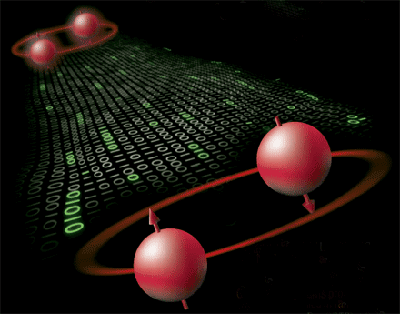Researchers achieve mathematical breakthrough that could lead to actual teleportation
Protocol sets rules for effective transport of quantum information at the speed of light
BY JEFFREY BAUSCH
For the last decade, theoretical physicists have been working to prove that the intense connections between particles as established in the quantum law of “entanglement” could be used as a more effective way to teleport quantum bits of information.

Researchers believe “entanglement” holds the key to a more effective form of teleportation. (Image via: zmescience.com)
Recently, researchers from Cambridge University published a mathematical solution in which they worked out how entanglement could be “recycled” to increase the efficiency of these connections, and demonstrating a new protocol that could open the door to several potential applications.
Quantum law and “entanglement” — how it works
In 1993 a team of scientists calculated that teleportation could work in principle using quantum laws. They based this on the understanding that quantum teleportation harnesses the “entanglement” law when transmitting tiny bytes of information across vast distances in an instant.
You see, entanglement involves two particles (e.g. electrons, protons, etc.) that are intrinsically bound together and retain synchronization whether they’re next to one another or on opposite sides of the globe. Using this connection, quantum bits of information can be relayed instantaneously using traditional forms of communication.
Under this theory, two teleportation protocols were developed: one that could send scrambled information that required correction by the receiver, or a bit more recently, “port-based” teleportation that doesn’t require the correcting of information by the receiver, but rather a ridiculous amount of entanglement, so much so that each object sent would destroy the entangled state.
Needless to say, these were not the most effective solutions. But that’s what makes the Cambridge discover so exciting. They’ve developed a new protocol in which the entangled state is “recycled” so that the gateway between particles can hold for the teleportation of more than one bit of information at a time. In fact, their protocol allows for multiple bits of quantum information to be sent at the same time.
The only problem they ran into is that the entangled state shows a proportional degradation to the amount of information being sent, whether it’s one quantum bit of information or multiple. It’s not a complete destruction of the entangled state, as was seen in the port-based teleportation solution, but a degradation nonetheless.
“The first protocol consists of sequentially teleporting states, and the second teleports them in a bulk,” said Sergii Strelchuk from Cambridge’s Department of Applied Mathematics and Theoretical Physics, who led the research with colleagues Jonathan Oppenheim of Cambridge and UCL and Michal Horodecki of the University of Gdansk. “We have also found a generalized teleportation technique which we hope will find applications in areas such as quantum computation.”
Outlook
“There is a close connection between teleportation and quantum computers, which are devices which exploit quantum mechanics to perform computations which would not be feasible on a classical computer,” said Strelchuk. “Building a quantum computer is one of the great challenges of modern physics, and it is hoped that the new teleportation protocol will lead to advances in this area.”
The group’s discovery comes hot on the heels of last year’s breakthrough by a team of Chinese scientists who reported teleporting photons over 89 miles (143km), breaking several previous records.
As a result, quantum entanglement is seen as an increasingly important area of scientific research. It is now realistic to think that we can teleport bits of information on a single atom, though we are probably still a long way away from being able to teleport actual human bodies.
Strelchuk concludes: “Entanglement can be thought of as the fuel, which powers teleportation. Our protocol is more fuel efficient, able to use entanglement thriftily while eliminating the need for error correction.”
The paper
Good in math? You’ll likely enjoy the group’s paper. Entitled Generalized Teleportation and Entanglement Recycling , it is the paper that Strelchuk and his team put together and published in Physical Review Letter, which you can download for free here. ■
Story via: cam.ac.uk
Advertisement
Learn more about Electronic Products Magazine





